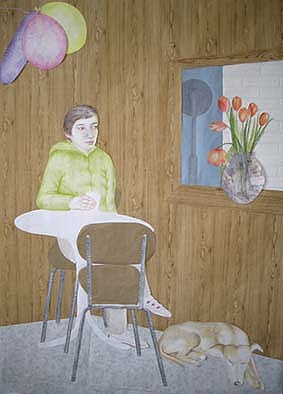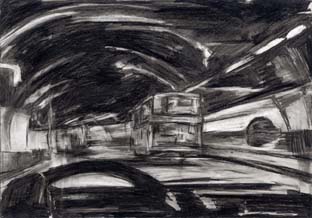
|

|
|
SIGNS
SIGNS in black and white, colour
April 28 - May 28, 2005 Vibe Bredhal (DK) Gudny Gudmundsdottir (IS) Kristofer Hultenberg (DK) Stephan Mörsch (D) Karena Nomi (DK) Patrick Rieve (D) Mette Thiessen (DK) Curated by Gitte Broeng
SIGNS in black and white, colour present drawings by 7 young artists, who draw in 7 very different ways. Together they offer a rich insight in the visual and formal potential of contemporary drawing practice. The show in Martin Asbæk Projects is a "boom" of works on paper – made with crayon, Indian ink, acrylic, carbon and ordinary pencil. In different formats from monumental to A-4. The drawings move from the simple, graphic line of comics in the work of Patrick Rieve. To the almost physical space of a collage in Mette Thiessen's "close-to-reality" interpretation of the (existential) vacuum arising after a party, when the guests are gone. And self-willed (de)constructions in the airy drawings of Gudny Gudmundsdottir. As well as Kristofer Hultenberg's odd abstract signs, which at first glance look like something you know – e.g. kitchen hardware – but in the end they refuse any sort of logic communication. Drawing does not have the same "heavy" tradition as painting and sculpture. Traditionally drawing has had an inferior status as the initial step before the actual work. Or as a means to rapidly reproducing visual impressions or ideas, which is a historical characteristic of drawing examined by Stephan Mörsch in his "reportage drawings" – sketched in speed, while walking on the street, driving in a car at the Autobahn etc. Karena Nomi is also approaching a traditional feature in drawing: the human anatomy. In this case exposed to carbon paper and fluorescent cardboard.
The historical insignificance of drawing has created a specific "free space", that seems to attract many contemporary artists. At least drawings (as autonomous art works) are being created as never before. Not just in formats in the size of a sketchbook but in big formats assured of themselves as is the case with Vibe Bredahl and her monumental drawing in Indian ink interpreting a Chinese proverb. |
| Dansk version | English version |
|
||||||||||||||||||||||||
| TOP |

